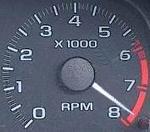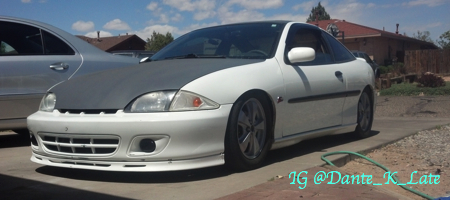Disclaimer: I offer these instructions in the hope that it helps others, just as many on this forum have helped me. I'm not a car care professional and I don't know if my instructions are correct, so following these instructions may cause serious injury, damage, or even death. If you choose to follow my instructions I take no responsibility for the results. Beware! I made these notes for myself, but I figured I'd post them here in case it helps anyone else, since many of the posts here have helped me.
I wrote these instructions based on my 1996 Cavalier, and I believe they apply to 1992-2004 Cavaliers & Sunfires, but I'm not 100% sure so you should double-check.
Time required to do this job: This should take about 2 hours the first time you do it if you're a novice like me. (You could probably do it in about 1 hour the second time.) My local shop said that it would take them about 50 minutes. I've only done this job one time, and all the bolts and parts easily came off (much to my surprise.) Many of the instructional videos that I watched warned of rusted-in bolts and parts, and if you have such a problem, I could see this job taking longer.
Diagnosing the problem: When the wheel bearing (called a "hub assembly" in this generation of Cavalier/Sunfire) goes bad, it will usually start making noise as the car rolls. That sound is typically like the soft roar of a jet engine wiht the volume and pitch typically increasing as the car rolls faster. Depending on how the bearing fails, the sound may be more like a "wup, wup, wup" or a grinding sound-- or it may even completely seize up. Once you notice the problem you should not drive the car much because it can fail by seizing or even falling apart so that wheel falls off.
Choosing a replacement hub assembly: Note that the front hub assemblies are different than the back hub assemblies, but there is no difference between the right and the left. All three of my local auto parts stores had two choices of front hub assemblies in two price ranges, ~$50 or ~$80. From what I read, it pays to buy a high quality brand hub assembly, but from what I read, some of the more expensive hub assemblies at my local stores were reportedly lower quality. Supposedly the cheaper ones fail more quickly. Based on my research Timken is reportedly one of the better brands, SKF is also reportedly good. National may also be good. Beware of the rest. I was able to buy a Timken #513017k on Amazon for $57, which was nearly as cheap as the low-end ($50) parts sold at my local auto parts stores.
Note that most of these hub assembly packages include an O-ring and washer which are needed for other car models but aren't needed for the Cavlier & Sunfire, and a hub nut which you should use to replace your old hub nut.
Tools required: Most of the tools are fairly normal do-it-yourself tools, but there are 3 required tools which aren't very normal. (1) A T-55 Torx bit for a ratchet wrench (~$5 at stores like O'Reilly's). (2) A 3/8" Allen wrench socket to remove the brake calipers (~$5 at O'Reilly's). (3) A 30mm socket for the hub nut. (4) A torque wrench. OíReillyís lends (for free) tools such as the torque wrench & 30mm socket, so I borrowed them from O'Reilly's. (I'm not sure if other auto parts stores do this also.) Going back and forth to get tools took a lot of time so gather them up at once. Youíll need:
a. Big flat-head screwdriver to remove hub caps.
b. Hydraulic jack.
c. Jack stands to put under frame as fail-safe, in case you accidentally knock the car off the jack.
d. Air compressor, impact wrench, & air tool oil (optionally to make the job go faster). Otherwise use a lug nut wrench.
e. Wire brush to clean off the rust and crust (or optionally a drill with a wire brush attachments).
f. At least one paper towel (or deposable rag).
g. Anti-seize goop.
h. Ratchet wrench (probably 1/2", perhaps also with a 1/2" to 3/8" adapter.
i. T-55 Torx bit for ratchet wrench.
j. 3/8Ē Allen wrench bit for ratchet wrench.
k. Mechanics wire (to hang brake caliper).
l. Hammer.
m. Rubber mallet.
n. Grease gun (optionally to lube the fittings as long as youíre in there).
o. Workmanís gloves (to prevent injury to your hands).
p. Disposable latex, vinyl, or nitrile gloves if you donít want your hands to get black.
q. A portable light or good lighting.
r. Penetrating oil. (You may need this if anything is rusted in, but hopefully you won't).
s. A low stool to sit on if you're not putting the car up on a hoist.
Instructions: As of 12/12, there were some very helpful videos on YouTube that showed how to diagnose and replace a failed hub assembly. I don't know if how long those YouTube videos will remain posted, but I'll provide the links here just in case. If these links don't work, you may want to search YouTube for instructional videos.
*
This guy did a YouTube video where he recorded the sound and told you how to diagnose which side failed.
*
This guy did an excellent video showing EXACTLY how to do the job. One thing that he doesnít mention is that for the front wheels youíll need to put the car in neutral so that you can spin the hub in order to access the Torx bolts.
Just in case the aforementioned YouTube videos no longer exist basically, the job goes something like the following.
Of course that the car should be in a safe, level, location.
1. Determine which wheel is the problem (only on cars with a normal slip differential like the Cavalier/Sunfire) by jacking up one front wheel, putting the emergency brake on, putting your foot on the brake, starting the car, putting the car in drive (or gear) and then slowly letting your foot off the brake so that the wheel spins. If you hear the noise, itís that wheel. If not, try the other side.
2. Take off the hub cap, if you have one.
3. Use a wire brush on the drill to clean off the rust from the hub bolt.
4. Remove the hub nut (and washer) with the 30mm socket on the torque wrench (without the car being jacked up).
5. Block the wheels to prevent rolling, firmly apply the emergency brake, and put the car in neutral.
6. Jack up the car and put blocks under the frame.
7. Remove the wheel.
8. Remove the brake caliper and hang it from the strut using mechanic's wire. I'm not going into detail about this since it's a basic DIY job with lots of instruction manuals out there. (Don't let the caliper hang by the brake fluid line.) Use a 3/8Ē Allen wrench on a socket to remove the two bolts from the engine-side of the caliper. Be sure to pull the bolts out enough that they donít touch inside the connecting hole. Compress the master cylinder with a big channel lock (or C-clamp) so that you can remove the caliper.
9. Tap the hub nut with a hammer until it breaks free. Then tap it with a rubber mallet to loosen it further. But don't smash it too far or you can damage the CV joint.
10. Spin the hub so that you can access one of the Torx bolts and clean out the Torx heads if necessary to securely insert the Torx bit. Put the T-55 Torx bit in the hole and give it a few moderate whacks with a hammer to loosen any crust. (This may not be necessary.) Then use the ratchet or torque wrench to remove each of the 3 Torx bolts.
11. Clean everything (including the bolts, washers, knuckle, etc.) of rust, crust, & grime using a wire brush, and then apply anti-seize to relevant areas.
12. Reassemble, noting that following nuts get tightened to these specs. 3 Torx bolts = 70 ft-lbs. 2 Brake-caliper bolts = 40 ft-lbs. Hub nut with washer = 185 ft-lbs. Lug nuts = 100 ft-lbs. You should double check GM's official torque settings since the aforementioned torque settings came from my Chilton's manual and may not be correct.
13. Remove any jack stands lower the car. Then remove the wheel blocks.
14.
Remember that you need to pump the brake pedal several times until it firms up in order to pump brake fluid into the brakes before driving, otherwise your brakes won't work!
15.
Carefully take it for a test drive, realizing that this is a deadly-critical component of the car.
I hope this helps.



